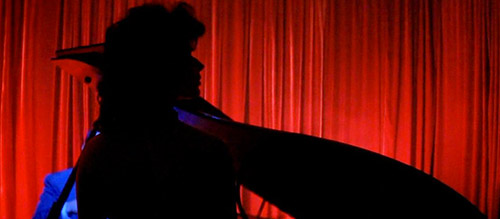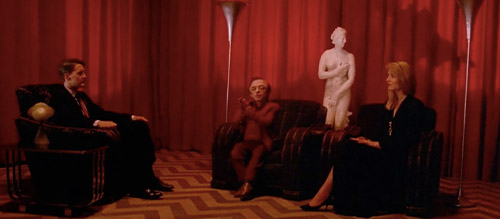Where to Start with David Lynch
“Discomfort” may best describe the feeling of viewing a David Lynch film. His works have been criticized for depictions of violence and sadism, as well as their lack of coherence. But harsh reactions are often signs of effective art, and there’s no doubt in Lynch’s ability to affect viewers.
Perhaps it’s better to frame Lynch’s films as “pictures” because of his background as a painter. Lynch began painting at a studio in high school, and it was a few years before he began to see the cinematic potential of his work. While looking at a completed piece, Lynch began hearing wind emanating from the canvas. He developed a fascination with creating moving paintings with sound – crude animations led to haunting short pictures like The Alphabet, where he experimented with the horrifying potential of design and form. Lynch sees film as a series of paintings meant to evoke feeling. His intuitive process involves playing with sound and light to produce the correct feeling, and maintaining his emotional vision is the most important aspect of any picture he creates.
Lynch’s pictures often deal with the intersection of reality and the subconscious. They’re an expression of ideas that couldn’t be articulated verbally. They use dream logic to connect the disconnected, and to sever any direct meaning. His pictures explore the underbelly of reality, the dark side of everyday surroundings. They also celebrate the simple pleasures in life, like a fresh cup of coffee or a photograph of a loved one. The best way to approach a Lynch picture is to drop potential assumptions and expectations so that the art washes over you (he refers to this as “room to dream”). It’s more about the experience and how it affects you than it is about the narrative, and going into a Lynch mystery expecting more answers than questions will undoubtedly leave viewers eternally frustrated.
There’s a surprising amount to explore in the Lynch picture library, from shorts to web series to television shows, but these are the best places to begin approaching his iconic and fabled work.
1. The Elephant Man
The Elephant Man Review
One of the director’s most coherent works tells the true story of “The Elephant Man” Joseph Merrick’s arrival and treatment at a London Hospital by Dr. Frederick Treves. Shot in striking high-contrast black and white, the picture shows humanity’s endless capacities for cruelty and empathy. It was such a successful outing for Lynch that it was nominated for eight Academy Awards, including Best Picture and Best Director (though it came away with no wins).
Anthony Hopkins and John Hurt star as Treves and Merrick respectively, though its Merrick’s interactions with the endless stream of gawkers and guests that steal the show. These encounters leave Treves to wonder whether he is any better than the man that exhibited Merrick as “The Elephant Man” in travelling carnivals. Hurt displays an incredible ability to express under the weight of prosthetics, and his performance paid great homage to Merrick’s long-lasting dignity and legacy.
The main Lynchian element here is the literalization of the story told by Merrick’s carnival exhibitor, in which “The Elephant Man” was brought about following an encounter between an elephant and a woman on an uncharted African island. The sequence is told in jarring, dreamlike form with crossfaded images of woman and elephant. Characters share Lynch’s desire to dive beneath the surface of acts and questions, and use various forms of art as a means of expression for beliefs and desires. The filmmaker’s success with The Elephant Man prompted George Lucas to offer him the opportunity to direct Return of the Jedi, which Lynch turned down in favor of a partnership with Dino de Laurentiis (with whom he made Dune and Blue Velvet). Above all, The Elephant Man shows Lynch’s talent as a filmmaker, and shows his capability with narrative that allows for him to construct his strange pictures so masterfully.
Recommended for you: Where to Start with Akira Kurosawa
2. Blue Velvet
Blue Velvet is the first of Lynch’s bizarre mysteries – it starts with Kyle MacLachlan and Laura Dern acting as amateur detectives after MacLachlan’s character discovers a severed ear in a field.
This erotic thriller exists in a dream state. Its suburban Americana could be mistaken for 1950s noir era rather than the mid-80s due to the abundance of period mise-en-scene. The innocence of its setting and protagonists is a phenomenal contrast to the dark, twisted intensity of Dennis Hopper and his criminal underworld. Violent sexual imagery is cast against beautifully colored sets, costumes, and lighting. Lynch plays with form throughout, and the picture’s soundtrack (containing the apt “In Dreams” and multiple variations of “Blue Velvet”) stands out among his excellent musical selections.
Blue Velvet serves as a great introduction to Lynch’s particular brand of weirdness due to its linear narrative and persistent symbolism. It shows how Lynch effectively uses the different elements of filmmaking to evoke moods and feelings while avoiding the bourgeoise constriction of absolute meaning. This is about as “normal” as Lynch’s signature pictures get before disappearing entirely down the rabbit hole to his cynical Wonderland, making it a key point in his career and a fantastic starting point when approaching his work.
3. Twin Peaks
Twin Peaks is a transmedia story, crossing through television, film, and books. The television show is the primary media, but the film, Twin Peaks: Fire Walk with Me, is an essential part of attempting to interpret the text as a whole. The first two seasons (which ran from 1990-91) follow Agent Dale Cooper, a quirky FBI agent, as he investigates the murder of high school student Laura Palmer. It quickly drifts into the realm of the surreal, with every answer prompting many more questions in the process.
Fire Walk With Me (a prequel to the first two seasons) can potentially be viewed as a singular work without the show, but a lot of the symbolism and meaning is lost without seeing the television series first. Some parts wouldn’t make sense to viewers until the 2017 release of the third season, in the most liberal understanding of “making sense”. The picture still serves as an essential component of the Lynch catalogue, as the limiting chains of network television no longer restricted Lynch’s ability to convey the most horrific elements of the show’s universe. It might be the most disturbing work in Lynch’s catalogue, and serves as the pinnacle of dark surreal Lynchian imagery.
Be prepared for a stark contrast between the first two seasons, the film, and the final season. Many fans of the show hated the movie for its lack of answers following a cliffhanger, and others disliked the third season’s presentation and change in tone. The entirety of the work is probably Lynch’s greatest achievement though, and essential viewing for anyone who wants to get into Lynch’s work as an artist. Above all, Twin Peaks shows that David Lynch’s ability to combine nostalgia, mystery and dream logic cannot be matched in narrative fiction.
Recommended for you: Where to Start with Terrence Malick
Lynch stands out as a unique figure in film history due to his position as a master of surreal form and content. He is to filmmaking what Dalí was to painting, popularizing a new perspective on meaning in Hollywood pictures. Lynch offers a radical freedom to viewers, requiring subjective interpretation conjured from the mind of the viewer for understanding rather than dictation from the screen. His moving paintings with sound require complete experiential immersion to achieve their full potential, but come with the benefit of allowing viewers to brush with the spiritual in the physical realm.




